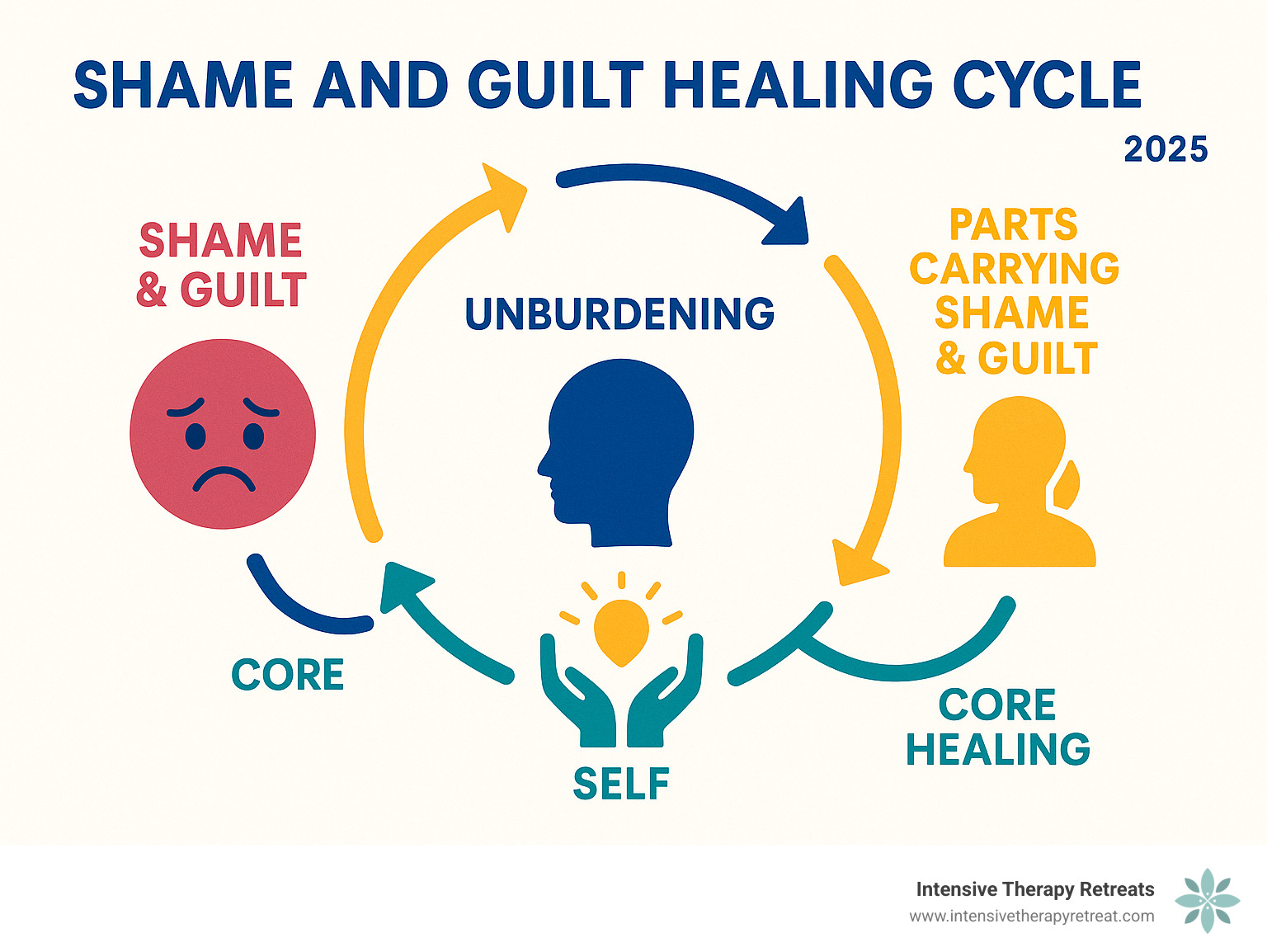Why Internal Family Systems Therapy Offers Hope for Shame and Guilt
Struggling with deep emotional wounds from shame and guilt? You’re not alone. Many are turning to internal family systems therapy for shame and guilt pdf resources for accessible ways to understand and heal these painful experiences.
Quick Guide to IFS for Shame and Guilt:
- Shame vs. Guilt: Shame says “I am bad” (about your core self), while guilt says “I did something bad” (about your actions)
- The IFS Approach: Views your mind as containing different “parts” – some carrying shame and guilt from past wounds
- Core Healing: Accessing your true “Self” – the compassionate, wise part of you that can heal wounded parts
- Key Techniques: Unblending from critical parts, befriending exiled parts, and releasing old burdens through “unburdening”
- Why It Works: IFS doesn’t pathologize shame – it sees it as a protective strategy that can be healed with self-compassion
Shame and guilt can deeply affect your life, influencing decisions, relationships, and self-perception in ways that feel out of your control.
The Internal Family Systems model offers a non-pathologizing approach that views shame not as a character flaw, but as a protective part of you trying to keep you safe. Research shows that shame is instrumental in many psychiatric symptoms, while healthy guilt can be adaptive. The key is learning to regulate shame while allowing space for appropriate guilt.
As a trauma therapist with decades of experience, I’ve seen how IFS helps people approach their wounded parts with curiosity instead of criticism, leading to profound healing. Resources like an internal family systems therapy for shame and guilt pdf can be a great complement to therapeutic work.
Understanding Shame and Guilt Through the IFS Lens
The journey toward healing begins with understanding what we’re actually working with. When we dive into internal family systems therapy for shame and guilt pdf resources, we’re essentially learning a new language for our inner world – one that’s surprisingly gentle and hopeful.
What is Internal Family Systems (IFS) Therapy?
Internal Family Systems (IFS) therapy views your mind not as a monolith, but as an inner family of different “parts.”
Dr. Richard Schwartz, the founder of IFS, finded that our minds are naturally multiple. This multiplicity is not a sign of pathology; it’s a normal, healthy aspect of being human.
These parts are distinct mental systems with their own feelings and intentions. For example, you might have a part that’s confident at work and another that’s playful with friends.
A core tenet of IFS is that there are no bad parts. Even critical or avoidant parts have a positive intent—they’re trying to protect you, even if their methods are painful.
At your core is the Self, an essence of wisdom, compassion, and clarity that is never damaged. It can be overshadowed by protective parts, but it’s always there.
The goal of IFS is not to eliminate parts but to foster Self-leadership, allowing your Self to guide your inner system so that all parts can heal. You can explore more about this transformative process in our guide on How Does Internal Family Systems Therapy Work?.
The Crucial Difference: Is It Shame or Guilt?
Distinguishing between shame and guilt is a crucial step in healing. Though often intertwined, they require different approaches.
Guilt is the feeling “I did something bad.” It’s focused on behavior and can be healthy and adaptive, motivating us to repair harm and learn from our mistakes.
Shame is the feeling “I am bad.” It attacks your core identity, making you feel flawed or unworthy. This toxic shame is often destructive to mental health.
While adaptive guilt is helpful, research links shame to many psychiatric symptoms. Learning to differentiate them is key.
| Characteristic | Shame | Guilt |
|---|---|---|
| Focus | “I am bad” (self-perception, core identity) | “I did something bad” (behavior, action) |
| Origin | Often from early experiences where our feelings, needs, or drives were shamed; feeling fundamentally flawed. | Violation of a moral code, personal values, or causing harm. |
| Impact | Leads to feelings of worthlessness, defectiveness, desire to hide or disappear, often linked to psychiatric symptoms. | Leads to remorse, regret, desire to make amends, learn, and grow. |
| Motivation | Can lead to withdrawal, defensiveness, self-attack, or destructive behaviors (e.g., addictions, self-harm) to escape the feeling. | Motivates reparation, apology, improved behavior, personal responsibility. |
| Adaptive? | Toxic shame is maladaptive; healthy shame (humility, acknowledging limits) can be adaptive. | Pure guilt is adaptive and prosocial; can become maladaptive if linked with shame or becomes excessive. |
It’s also worth noting healthy shame, which is more like humility—a gentle acknowledgment of our human imperfections.
How Our Inner ‘Parts’ Carry Shame and Guilt
In IFS, shame and guilt are not abstract emotions; they are carried by specific parts, each with a story and a protective role.
Exiles are our young, vulnerable parts that carry pain from trauma or childhood wounds. They often hold beliefs like “I’m unlovable” and are hidden away because their pain feels overwhelming.
Managers are proactive protectors that work to prevent Exiles from being hurt. They can manifest as an inner critic or perfectionism, using shame as a tool to keep you safe from perceived threats like rejection.
Firefighters are reactive protectors that jump in when an Exile’s pain breaks through. They try to douse the emotional fire with numbing behaviors like addictions or compulsions, which can provide immediate relief but often lead to more shame later.
IFS reveals a beautiful truth: shame-based strategies originate from a place of protection. These parts adopted their roles to help you survive difficult circumstances, believing their actions were necessary for your safety.
Healing means helping these parts find new, healthier roles, not eliminating them. By approaching them with curiosity, we build trust, allowing them to share their stories and release their burdens.
This makes IFS ideally suited for trauma survivors as it honors the positive intent behind even the most painful internal dynamics, rather than pathologizing them. You can learn more about this approach in our article on The Power of Internal Family Systems (IFS) to Steer Trauma.
The Healing Process: Your Guide to Internal Family Systems Therapy for Shame and Guilt PDF
The IFS healing journey is a gentle homecoming. It’s not about forcing change but turning toward your inner world with kindness.
This approach recognizes that you already have everything you need to heal: your core Self, which has been waiting patiently beneath the layers of your protective parts.
Accessing Your Core Self: The Source of Healing
Your Self is like the steady, loving parent your inner parts need. It’s your fundamental essence—whole, undamaged, and capable of healing your internal family.
When you lead from the Self, you naturally embody the 8 C’s of Self-energy. These qualities emerge spontaneously when your parts allow your Self to lead. You’ll find Curiosity replacing judgment, Calm amidst difficult emotions, and Clarity in confusing situations. Confidence in your abilities grows, along with the Courage to face avoided parts. Compassion flows toward yourself, fostering a deep sense of Connection. Creativity emerges, helping you find new solutions to old patterns.
When parts carrying shame encounter this Self-energy, they begin to trust that it’s safe to share their stories and release their burdens.
Practical IFS Techniques for Working with Shameful Parts
The practical work of IFS is a gentle, systematic process. While an internal family systems therapy for shame and guilt pdf can introduce these concepts, professional support is often beneficial for deep shame.
The journey typically follows the 6 F’s: a roadmap for engaging with your parts. Finding a part means noticing it. Focusing is turning your attention toward it. Befriending is approaching it with warmth and curiosity, asking what it needs you to know. You then Feel for the part, sensing the burdens it carries. As trust builds, you can ask about its fears—what it worries will happen if it stops its protective role.
The most transformative step is unburdening, where an exiled part releases painful beliefs and emotions it absorbed during difficult experiences, like “I’m worthless.” This happens once the part feels safe. The process is often symbolic, using imagery like releasing burdens into a fire or water. The key is that the part feels genuinely lighter afterward.
For practical exercises and deeper exploration of these techniques, our Internal Family Systems Therapy Worksheets offer structured guidance for this inner work.
A Clinical Example: Healing Trauma-Related Shame
Consider Angie, 28, who came to therapy with unbearable shame and a core belief that she was “bad,” which traditional therapy hadn’t resolved.
In IFS, Angie met a harsh inner critic she called the “iron hand.” Initially, she hated this part, but by accessing her Self, she became curious about it.
She finded this critic was a young boy part, protecting an even younger girl part carrying overwhelming shame. The boy part believed his harshness prevented more pain.
As Angie’s Self appreciated the boy’s protective role, he softened and allowed her to connect with the guarded girl part. This part held both toxic shame (“I am bad”) and guilt related to her deceased brother.
With her therapist’s guidance, Angie’s Self helped these parts share their stories and differentiate between appropriate guilt and toxic shame.
The healing climaxed when a part wrote an apology letter to her brother, which a cricket in her inner world offered to deliver—a beautiful symbol of release.
The results were profound. Her chronic suicidal thoughts—a Firefighter’s attempt to escape the shame—disappeared. Once the underlying wound was healed, the extreme protective strategy was no longer needed.
This example illustrates how IFS can regulate overwhelming shame while honoring appropriate guilt, leading to genuine emotional freedom.
Overcoming Challenges and Fostering Self-Compassion
The IFS path is clear, but healing deep shame can have challenges. These are not roadblocks but signs of progress.
Common Pitfalls When Working with Shame and Guilt
Connecting with wounded parts can bring up resistance. This is normal; it’s your protective parts being cautious about approaching old pain.
A common experience is protector backlash, where Managers or Firefighters intensify their strategies (e.g., a louder inner critic, stronger urges to numb out) because they fear the healing work isn’t safe.
Another challenge is feeling blended with a part, where its feelings feel like your entire reality (e.g., “I AM worthless” vs. “A part of me feels worthless”). Patience is key here.
Trusting the process is essential. Healing takes time, and your parts need to feel safe before they can release their burdens.
Even therapists can have their parts activated, which is why working with a trained IFS therapist who understands these dynamics is so valuable.
Why IFS is a Non-Pathologizing Approach
IFS is unique because it reframes emotional pain. It sees shame and guilt not as symptoms to be eliminated, but as strategies that once made sense.
This shift from pathology to protection is transformative. Your inner critic is a Manager part trying to keep you safe; your numbing behaviors are a Firefighter part trying to protect you from overwhelming feelings.
IFS honors the positive intentions of all parts, which naturally moves us from self-criticism to self-compassion. When you approach this work from a place of compassion, you stop fighting parts of yourself and start appreciating their efforts.
This approach assumes your inherent goodness. Honoring all parts means recognizing their value once they are unburdened from past trauma.
This non-pathologizing stance is effective for many struggles. The goal is not to eliminate parts but to create inner harmony, where all parts contribute positively under the leadership of the Self. You can explore more about how this approach helps with various emotional challenges in our guide on Various Mental Health Conditions that IFS Can Help With.
Frequently Asked Questions about IFS for Shame and Guilt
As people explore IFS for shame and guilt, they often have important questions about the healing journey.
How long does it take to see results with internal family systems therapy for shame and guilt pdf-based learning?
Healing unfolds at its own pace. While an internal family systems therapy for shame and guilt pdf can provide valuable tools, the timeline depends on the depth of the wounds and the activation of protective parts.
A trained IFS therapist can often accelerate results by helping you steer resistance and safely work with complex internal systems created by trauma.
Our intensive retreats are specifically designed to create profound shifts in days rather than the months or years traditional therapy might take. By providing a focused, immersive environment, we can help you access deeper healing more rapidly.
Can I do IFS on myself for shame and guilt?
You can certainly begin this work on your own. Exploring resources like an internal family systems therapy for shame and guilt pdf, using workbooks, and practicing self-compassion can be very beneficial. This self-exploration is a powerful first step that can create meaningful change.
However, for deep shame or significant trauma, working with a trained IFS therapist is essential for safety. A therapist helps you access vulnerable parts without becoming overwhelmed by protectors. They provide a “safe container” and the skilled guidance needed to access your most wounded parts.
How is IFS different from other therapies for shame?
IFS differs from other therapies by viewing shame not as a disorder to be fixed, but as a burden carried by a wounded part or a protective strategy. This non-pathologizing approach sees your parts as doing their best to protect you, even if their methods have become extreme.
While other therapies may focus on changing thoughts or managing symptoms, IFS heals the relationships within your internal system, addressing the root causes of pain carried by your parts.
The emphasis on Self-led healing is also unique. The therapist isn’t the expert who fixes you; they are a guide who helps you access your own innate healing capacity.
Finally, IFS welcomes all parts. Instead of trying to eliminate difficult parts, we seek to understand their purpose and help them find healthier roles. This approach offers a fresh perspective that feels both deeply compassionate and remarkably effective for lasting change.
Begin Your Journey from Shame to Self-Leadership
Exploring resources on internal family systems therapy for shame and guilt pdf is a courageous first step. The path from deep shame to embracing your inherent worth is possible.
Imagine your life if the harsh inner voice saying “I am bad” softened into curiosity. Imagine learning from mistakes with compassion. This shift to self-leadership is the power of IFS.
You’re not alone. Shame and guilt often stem from past experiences that taught our parts to adopt protective strategies. These strategies served a purpose, but they don’t have to define your future.
The truth of IFS is that healing is possible because your core Self is never broken. It is always there, ready to lead with curiosity, calm, and compassion. Accessing this Self-energy transforms your inner world from one of criticism to one of kindness.
Our work at Intensive Therapy Retreats centers on helping people just like you reconnect with this inner wisdom. We’ve seen countless individuals move from feeling fundamentally flawed to embracing their wholeness. The intensive, immersive environment of our retreats allows for the kind of focused, deep work that can create lasting results in days rather than months or years.
There’s something uniquely powerful about stepping away from daily life to fully engage with your healing journey. In our retreats, you’re surrounded by skilled therapists trained in IFS, EMDR, and other trauma-informed approaches, all working together to create a safe container for your most vulnerable parts to finally be seen and heard.
You are not alone in this process. Every step of the way, you’ll be supported by professionals who understand the courage it takes to face shame and guilt head-on. We know how to help your protective parts feel safe enough to allow the real healing work to begin.
For those seeking profound and accelerated healing, an IFS retreat can provide the focused, supportive environment needed to transform your relationship with shame and guilt. Learn more about our IFS Therapy Retreats.



